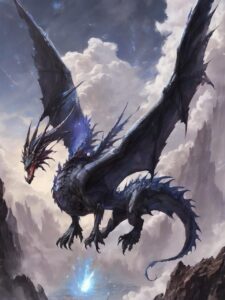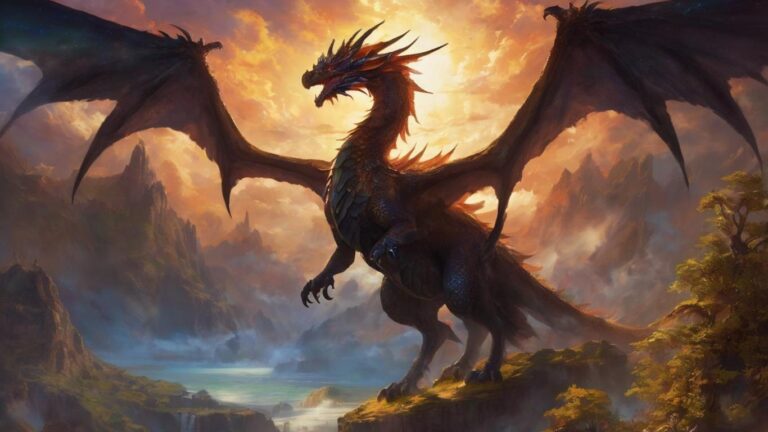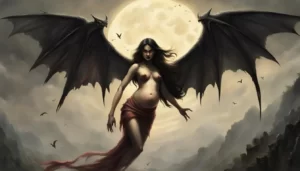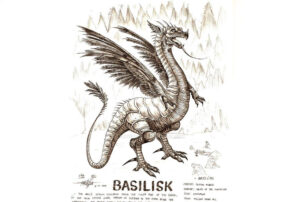Table of Contents
In the vast tapestry of mythical creatures, few shine as brightly as Bahamut, the celestial dragon of legendary proportions. This article embarks on a journey through ancient myths and contemporary interpretations, exploring the rich lore and cultural significance of Bahamut, a creature that has captivated the imaginations of diverse cultures across the globe.
Origins and Mythical Roots
Ancient Mythologies
Bahamut finds its roots in ancient mythologies, with the concept of a cosmic sea serpent or dragon existing in various cultures. In Arabian mythology, Bahamut is believed to be a colossal fish supporting the earth, while in Dungeons & Dragons, it has evolved into a benevolent and powerful dragon deity.
Cosmic Symbolism
In both Eastern and Western mythologies, Bahamut is often associated with cosmic symbolism. Representing primordial forces and celestial balance, Bahamut embodies the harmonious equilibrium between chaos and order, light and darkness.
Physical Description

Colossal Proportions
Bahamut’s physical presence is nothing short of awe-inspiring. Towering above ordinary dragons, its colossal proportions evoke a sense of magnificence and power. With wings that span the heavens and a body that rivals mountains, Bahamut commands attention and reverence.
Radiant Scales
The scales that adorn Bahamut’s majestic form are a spectacle in themselves. Radiant and shimmering, they catch and reflect the ambient light, creating an ethereal glow that bathes the dragon in celestial luminescence. These scales are not merely a protective armor but a testament to Bahamut’s divine essence.
Celestial Aura
Bahamut’s physical form is surrounded by an unmistakable celestial aura. As the embodiment of cosmic forces and equilibrium, the dragon radiates a divine energy that permeates its surroundings. This aura serves as both a beacon of celestial power and a visual manifestation of Bahamut’s sacred role in the cosmic order.
Enchanting Eyes
The eyes of Bahamut are often described as captivating and mesmerizing. Gleaming with wisdom and cosmic insight, these eyes are the windows to the dragon’s benevolent soul. Whether they glow with a soft luminescence or radiate a fierce light, Bahamut’s eyes convey an otherworldly intelligence.
Regal Horns and Crests
Bahamut’s regal appearance is further accentuated by majestic horns and crests that adorn its head. These ornate features, reminiscent of celestial crowns, add an extra layer of majesty to the dragon’s already imposing countenance.
Divine Wings
The wings of Bahamut are not just appendages for flight; they are extensions of celestial might. These expansive wings, capable of spanning entire skies, symbolize freedom, transcendence, and the dragon’s ability to traverse the realms with graceful authority.
In the pantheon of mythical beings, Bahamut’s physical description is a symphony of celestial elements, from its colossal frame and radiant scales to its enchanting eyes and divine wings. Each aspect contributes to the dragon’s enduring portrayal as a majestic and benevolent force in the rich tapestry of human mythology.
Special Abilities

Bahamut, the celestial dragon of mythical lore, possesses a myriad of Special Abilities that elevate it beyond the ordinary. As a cosmic entity embodying primordial forces, Bahamut’s abilities are awe-inspiring and reflect its status as a guardian and arbiter of celestial balance.
Cosmic Breath
Bahamut wields a breath weapon of unparalleled potency. Unlike typical dragons, Bahamut’s breath is not a destructive force but a manifestation of cosmic energies. It can unleash beams of radiant light or cascades of stardust, purifying and restoring rather than causing destruction.
Celestial Healing
One of Bahamut’s most benevolent abilities is its power of celestial healing. In times of cosmic imbalance or strife, Bahamut can channel rejuvenating energies, bestowing healing and renewal upon the celestial realms and those deemed worthy of its divine intervention.
Astral Communication
Bahamut possesses the ability to communicate across the astral plane. This transcendent form of communication allows the dragon to convey messages to other celestial beings, gods, or chosen mortal emissaries. This unique ability facilitates coordination in the cosmic order.
Dimensional Travel
The celestial dragon’s influence extends beyond the confines of the mortal realm. Bahamut can traverse different dimensions and planes, navigating the vast cosmic tapestry with ease. This ability grants the dragon unparalleled freedom to protect and maintain balance across realms.
Celestial Warding
To safeguard against malevolent forces that threaten cosmic harmony, Bahamut has the power of celestial warding. It can erect protective barriers infused with divine energy, shielding entire realms from the influence of chaos and preserving the delicate equilibrium of the celestial order.
Timeless Wisdom
Bahamut’s wisdom transcends the bounds of mortal understanding. As a repository of timeless knowledge, the dragon possesses an innate understanding of cosmic patterns, destiny, and the interconnectedness of all things. Its counsel is sought by gods and mortals alike.
Astral Empathy
Bahamut’s empathy extends across the astral plane, allowing it to sense the emotional currents and intentions of celestial beings. This empathic connection enables the dragon to discern the purity of heart in those who seek its guidance or protection.
Celestial Roar
In times of cosmic turmoil, Bahamut can unleash a resounding celestial roar. This mighty roar serves as a call to arms for celestial allies and a harbinger of impending cosmic justice. The vibrations from the roar resonate across dimensions, signaling the dragon’s unwavering commitment to maintaining order.
Bahamut’s special abilities, ranging from cosmic breath and celestial healing to astral communication and dimensional travel, position it as a divine guardian and cosmic force. Each ability reflects the dragon’s role as a benevolent entity dedicated to upholding the celestial balance and ensuring the harmonious progression of cosmic destinies.
Weaknesses
Despite its celestial might, Bahamut, like any mythical entity, is not impervious and possesses weaknesses that can be exploited by forces seeking to disrupt the cosmic balance it upholds.
Vulnerability to Chaotic Energies:
Bahamut’s celestial nature renders it vulnerable to chaotic and malevolent energies that disrupt the cosmic harmony. Entities harnessing chaotic forces can exploit this vulnerability, temporarily diminishing the dragon’s powers and impeding its ability to maintain balance.
Limited Temporal Influence:
While Bahamut transcends mortal understanding, its temporal influence is limited. Manipulating time or exploiting temporal anomalies can pose challenges to Bahamut’s strategic foresight, creating windows of opportunity for those who seek to disrupt its celestial guardianship.
Bound by Cosmic Laws:
Bahamut operates within the framework of cosmic laws and divine principles. Forces that exploit loopholes or manipulate these laws may find avenues to counteract the dragon’s actions, challenging its ability to enforce cosmic justice.
Reliance on Cosmic Equilibrium:
Bahamut’s strength is intricately tied to the stability and equilibrium of the celestial realms. Disrupting this balance through large-scale cosmic disturbances or manipulating the delicate interplay of forces can weaken Bahamut’s influence and effectiveness.
Susceptibility to Celestial Corruption:
While Bahamut embodies celestial purity, there exists a vulnerability to celestial corruption. Malevolent forces from other planes may attempt to corrupt the dragon, sowing seeds of discord within its celestial essence and compromising its ability to discern cosmic truths.
Dependence on Mortal Advocates:
Bahamut often relies on mortal champions and emissaries to carry out its will in the mortal realm. Threatening or manipulating these advocates can disrupt the dragon’s plans, as its influence relies on the dedication and righteousness of those who serve as its mortal agents.
Cosmic Fatigue:
The constant vigilance required to maintain cosmic balance can lead to a state of cosmic fatigue for Bahamut. Prolonged periods of intense cosmic disturbances or sustained efforts to disrupt the celestial order can exhaust the dragon’s energies, temporarily diminishing its powers.
Vulnerability During Astral Travel
While Bahamut’s ability to traverse dimensions is a strength, it also exposes a vulnerability. During astral travel, the dragon may be susceptible to attacks from astral entities or dimensional anomalies, requiring caution and strategic planning.
Bahamut’s weaknesses underscore the delicate interplay between cosmic forces and the challenges faced by even celestial beings in maintaining order. These vulnerabilities become pivotal points for those seeking to upset the balance and challenge the celestial dragon’s divine authority.
Bahamut in Different Cultures

Arabian Folklore
In Arabian folklore, Bahamut is a mythical fish supporting a bull, atop which rests an angel, who carries the earth. This unique interpretation showcases the diverse ways in which cultures envision and personify cosmic forces.
Dungeons & Dragons
Bahamut has become an iconic figure in fantasy literature and tabletop gaming, particularly in the Dungeons & Dragons (D&D) universe. Revered as the Platinum Dragon, Bahamut is depicted as a wise and benevolent deity, embodying justice and protection.
Cultural Impact
Pop Culture and Gaming
Bahamut’s influence extends into modern pop culture, with appearances in video games, literature, and various forms of entertainment. The celestial dragon has become a symbol of grandeur and power in the fantasy genre, captivating audiences worldwide.
Artistic Representations
Artists across centuries have been inspired by the myth of Bahamut, creating stunning visual representations that showcase the dragon’s majestic form, celestial surroundings, and symbolic significance.
In the vast tapestry of mythical creatures and cosmic entities, Bahamut is often associated with or referenced alongside a diverse array of related creatures, each contributing to the rich lore and cosmic narratives across different cultures and fantasy realms.
Tiamat
A counterpart to Bahamut, Tiamat is often portrayed as a multi-headed chromatic dragon, representing chaos and discord. The dynamic between Bahamut and Tiamat mirrors the eternal struggle between cosmic order and chaos in various mythologies.
Celestial Guardians
Bahamut is sometimes depicted alongside other celestial guardians, such as angelic beings or benevolent spirits. These entities share a common goal of upholding cosmic harmony and defending against forces that seek to disrupt the celestial order.
Cosmic Serpents
In certain mythologies, Bahamut is associated with cosmic serpents or world serpents that encircle the universe. These serpents symbolize the cyclical nature of cosmic existence and the eternal dance between creation and destruction.
Elemental Dragons
Bahamut’s influence extends to elemental dragons, each representing a specific element such as fire, water, earth, or air. These dragons, often aligned with the principles of cosmic balance, work in harmony with Bahamut to maintain order.
Astral Beings
Bahamut’s cosmic nature connects it with astral beings, such as celestial spirits or cosmic entities that exist beyond the material realm. These beings may serve as emissaries or allies in the dragon’s quest to preserve cosmic equilibrium.
Explanations of the Myth
The myth of Bahamut spans across various cultures and mythologies, with interpretations that reflect the universal themes of cosmic balance, order, and the eternal struggle between opposing forces. Here are some explanations of the myth:
Arabian Mythology
In Arabian mythology, Bahamut is described as a colossal fish that supports a bull, atop which rests an angel, who carries the earth. This symbolic representation reflects the interconnectedness of cosmic elements and the delicate balance that ensures the stability of the earthly realm.
Dungeons & Dragons
In the context of Dungeons & Dragons (D&D), Bahamut has evolved into a deity associated with metallic dragons and is revered as the Platinum Dragon. In this mythos, Bahamut embodies justice, protection, and the inherent goodness of dragons. The dragon deity is a symbol of benevolence and order, often in opposition to the chaotic Tiamat.
Cross-Cultural Symbolism
Bahamut’s myth exhibits cross-cultural symbolism, representing cosmic forces and celestial guardianship. Whether portrayed as a colossal fish, a celestial dragon, or a deity in dragon form, the myth transcends cultural boundaries, emphasizing the importance of maintaining harmony in the cosmos.
Celestial Harmony
At its core, the myth of Bahamut is a narrative of celestial harmony and the eternal struggle to uphold order against chaotic influences. The dragon serves as a guardian of cosmic balance, intervening when necessary to thwart forces that seek to disrupt the delicate equilibrium of the celestial realms.
Balance of Creation and Destruction
Bahamut’s myth often incorporates the concept of balance between creation and destruction. The dragon’s presence signifies the need for cosmic forces to coexist harmoniously, ensuring that creation and preservation counterbalance the inevitable forces of entropy and destruction.
Guardian of Mortal Realms
In certain interpretations, Bahamut extends its guardianship to mortal realms. Mortals who align with principles of justice, righteousness, and cosmic harmony may find themselves under the watchful eye of Bahamut, who may intervene in times of great need.
Cosmic Wisdom and Guidance
Bahamut is often associated with cosmic wisdom and guidance. Mortals seeking enlightenment or divine counsel may look to the dragon as a source of celestial knowledge, representing the interconnectedness of the mortal and celestial planes.
Symbol of Hope
The myth of Bahamut carries elements of hope and salvation. In times of cosmic turmoil or mortal crises, the dragon may emerge as a symbol of hope, inspiring champions to rise against darkness and restore balance to the realms.
Eternal Struggle
Bahamut’s myth encapsulates the eternal struggle between cosmic forces, mirroring the ongoing battle between order and chaos, light and darkness. The dragon’s enduring presence in mythologies underscores the timeless nature of these cosmic conflicts.
Bahamut’s myth, with its diverse interpretations and cultural variations, weaves a tale of celestial significance, cosmic balance, and the enduring quest for harmony across the realms of mythology and fantasy.




